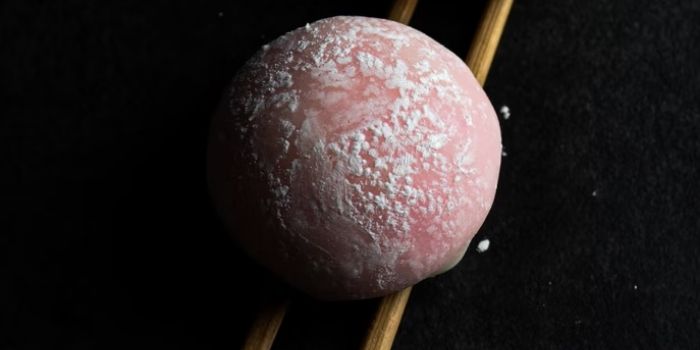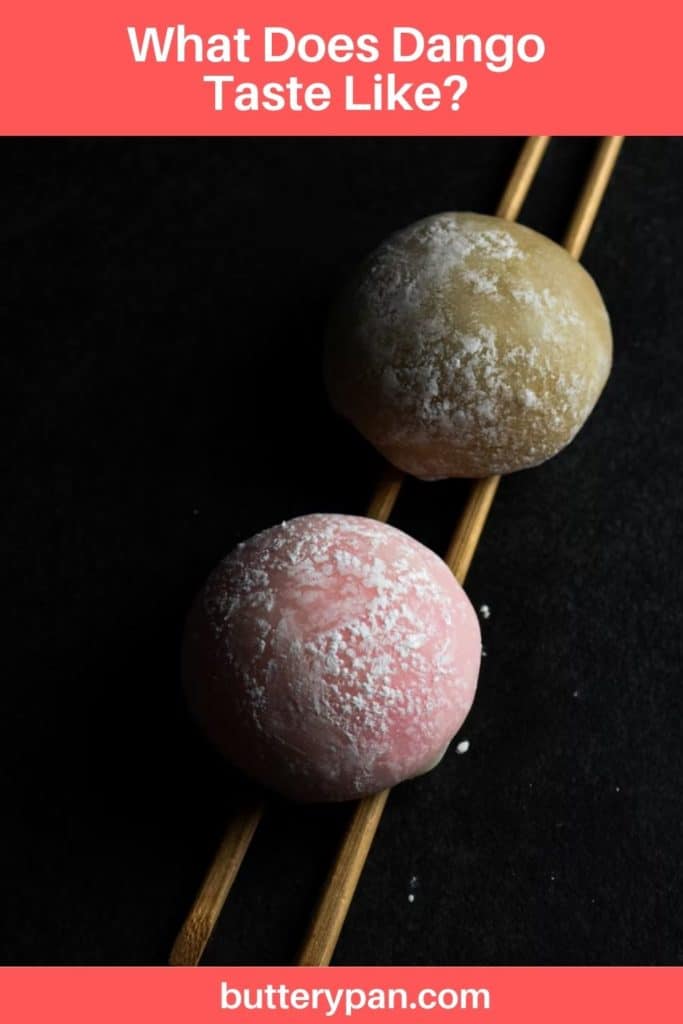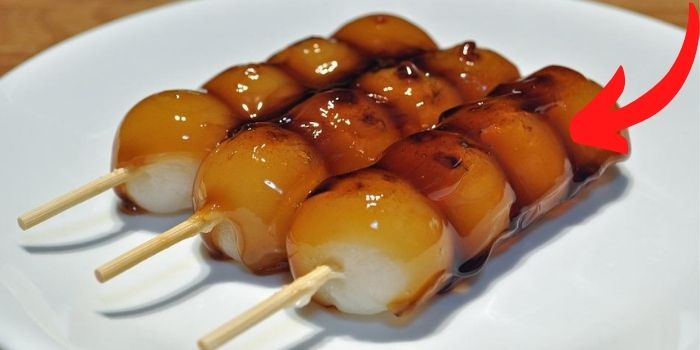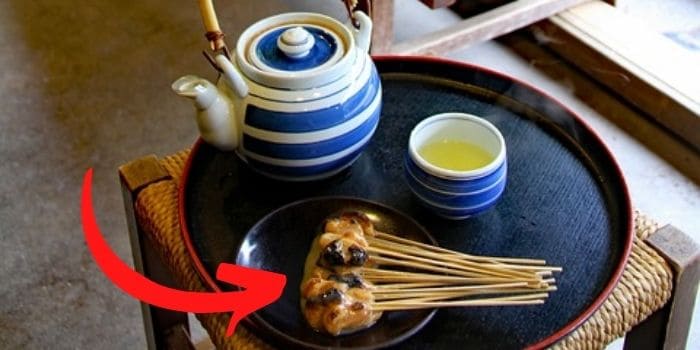What Does Dango Taste Like? What is Hanami Dango?

Wondering what does dango tastes like? Dango has a chewy texture and can be made with sweetened rice flour and flavoring or soy to add a savory flavor.
But in this post, we will go over much more than that.
We will cover what hanami dango is, how to prepare it many other great tips and info about his treat!
Let’s dive in.
Table of Contents
What is hanami dango?
Hanami dango is a Japanese dumpling made from rice flour and typically served on a skewer.
The name “hanami” comes from the Japanese word for “flower viewing,” These dumplings are often served during cherry blossom season.
They are usually white, but they can also be pink or green, depending on the ingredients and flavoring.
The dough is made by kneading rice flour with water, and it is then formed into small balls.
These balls are then steamed and skewered onto bamboo sticks.
You can eat the dumplings plain, or you may dip them in a sweet sauce before eating.

What does dango taste like?
Hanami dango comes in many different varieties, each with its unique flavor profile.
Some dango are flavored with things like chocolate or matcha, while others are more delicate and simple.
What they all have in common, though, is a soft and chewy texture that simply melts in your mouth.
Depending on the type of dango you try, it can taste buttery and rich, lightly sweet and fragrant, or even tangy and slightly sour.
Dango ingredients
The most common types of dango use:
- mochiko, or rice flour.
- white sugar (or similar sweetener)
- silken tofu
Dango is usually made with white rice flour, but some recipes call for brown rice flour or red bean flour.
It can also be made with different fruits and vegetables, such as pumpkin or sweet potato.
As for the color part, you can go with matcha powder to make it green, chocolate to make it dark, or strawberry to make it pink.
What is Dango filled with?
The most common filling for dango is azuki bean paste, but there are many other popular fillings, including matcha cream, chocolate, and peanut butter.
Dango can also be served plain, with just a dusting of sugar or soy sauce.
How to make hanami dango?
- Combine rice flour, sugar, and tofu. Squeeze, mix and knead it all together.
- Add the flavoring. You can separate the base and add different flavors to each of them;
- Separate into 10g balls;
- Drop them into boiling water and let them cook until they start to float;
- Drain them and put them on a paper towel to dry a bit.
Tips for the best hanami dango
- First, be sure to use fresh ingredients for the dough.
- Cook the dumplings for just long enough so that they are cooked through but still soft.
- If you’re using sweeteners, go light on the sugar so that the dumplings don’t become too cloying.
- When grilling dango, be careful not to overcook them – they should be slightly browned on the outside but still soft in the center.
- Serve dango with a dipping sauce such as soy milk or kinako syrup – this will help to bring out the flavor of the dumplings.
Japanese dessert recipes
If you would like to explore other Japanese desserts, here are a few recipes:
What is tricolor dango?
Tricolor dango is made of three colors of mochi (rice cakes)
- Pink;
- White;
- Green.
The pink one is usually flavored with strawberry, the white one with bean paste, and the green one with matcha.
What does tricolor dango taste like?
- White dango has a neutral sweet taste.
- Pink dango is similar to the strawberry mochi strain, with a light strawberry taste.
- Green dango is a chewy cake with a hint of matcha tea.
Dango vs. Mochi: Main Differences
Dango and mochi are popular Japanese treats, but they each have different characteristics that set them apart.
Dango is made of rice flour and typically comes in bite-sized little balls, while mochi is smooth and chewy, often served as square blocks.
Dango tends to be savory rather than sweet, with various flavors and toppings available.
In contrast, mochi can be eaten plain or as a filling for other desserts, including matcha cream or ice cream.
What does hanami dango taste like?
Hanami dango is the same as dango. So the taste description in the upper part of the post applies.
Mitarashi dango vs. Hanami dango: What is the difference?
Mitarashi dango and Hanami dango are both Japanese sweet dumplings made from rice flour and served on a skewer.
The biggest difference between the two is their topping.
Mitarashi dango is coated in a sweet soy sauce glaze, while Hanami dango is rolled in kinako (roasted soybean) powder.

Both are popular snacks sold at street stalls and festivals across Japan, but Mitarashi dango is more commonly found year-round. At the same time, Hanami dangos are mainly eaten during cherry blossom season.
What does mitarashi dango taste like?
Mitarashi dango consists of little balls of sweet rice flour dough, grilled and coated in a sticky, sweet sauce.
The sauce is usually made from soy sauce, sugar, and mirin (a type of rice wine). It gives the dango a deep, rich flavor.
The dumplings are soft and chewy, making for a delicious contrast with the sticky sauce.
Best toppings for dango
- Kinako -a toasted soybean powder that has a nutty flavor;
- Anko – sweet red bean paste;
- Cinnamon sugar;
- Green tea powder.
You can even try savory toppings like cheese or bacon bits if you’re feeling adventurous.
What do dango dumplings taste like?
Dango dumplings are generally sweet but can also be savory. The most common type of dango is made with anko (red bean paste), but many other flavors are available, such as matcha (green tea), cheese, chocolate, and pumpkin.
All flavors have one thing in common, their chewy texture.
Dango dumplings are a popular snack in Japan and can be found at most convenience stores and supermarkets.
Does dango taste like mochi?
They both have a chewy texture and are often flavored with sweeteners such as sugar or honey.
However, dango is typically cooked over charcoal (it can also be boiled), giving it a smoky flavor that mochi doesn’t have.

Additionally, dango is often served with savory toppings such as soy sauce or miso, while mochi is usually served with sweet toppings such as red bean paste.
So, while they may look similar, dango and mochi have distinct tastes that set them apart.
Are dango sweet?
While some dango are savory, most are sweet.
The sweetness of dango comes from adding either sugar or honey to the dough.
Dango can be served alone or with other ingredients, and they are often skewered onto a stick before being cooked.
Once they are cooked, dango are typically topped with a sweet sauce or syrup.
While dango is generally considered quite sweet, the exact level of sweetness can vary depending on the recipe.
What does dango feel like?
The outside of the dango is typically coated in a sticky sweetener, such as honey or sugar. At the same time, the inside can be filled with various flavorful ingredients, such as mochi and red bean paste.
The chewy texture of the rice dough gives each piece an almost springy texture. Yet, it is still soft enough to melt in your mouth.
Is dango savory or sweet?
Dango is made from rice flour, so it has a neutral taste.
However, it’s often served with a sweet sauce, which gives it a slightly sweet flavor.
It can also be served with a savory dipping sauce, giving it a savory taste.
So, ultimately, whether dango is savory or sweet depends on how it’s prepared.
Are dango healthy?
Dango are usually pretty healthy, as they’re low in fat and calories.
However, they can be quite high in sugar, so it’s important to eat them in moderation.
If you’re looking for a healthy snack, opt for dango made with brown sugar or honey.
These versions tend to be lower in sugar and contain more nutrients than those made with white sugar.
Related Posts
Summary
Now you know what dango is and what it tastes like. It is a chewy, usually sweet round cake made from rice flour.
You also know that it can be either savory or sweet, depending on its preparation.
And finally, you know that dango is generally healthy, but it’s important to eat them in moderation because they can be high in sugar.